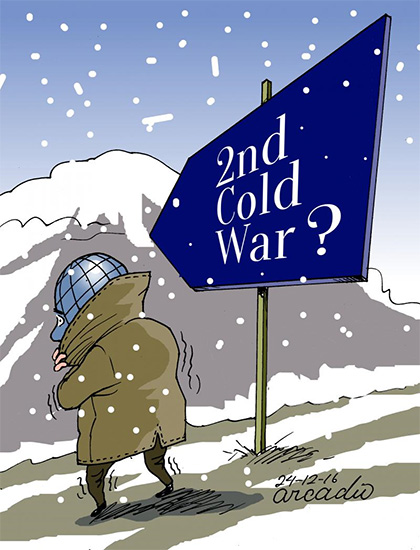
Speaker Mike Johnson pressed ahead with a bill that would restore US aid to Ukraine. “We are going to stand for freedom and make sure that Vladimir Putin doesn’t march through Europe,” Johnson declared. “We have to project to Putin, Xi, and Iran, and North Korea, and anybody else that we will defend freedom.”
Zbigniew Brzezinski, President Jimmy Carter’s national security adviser, as long ago as 1997, in his book ‘The Grand Chessboard’ wrote:
“Potentially, the most dangerous scenario would be a grand coalition of China, Russia, and perhaps Iran, an “antihegemonic” coalition united not by ideology but by complementary grievances. It would be reminiscent in scale and scope of the challenge once posed by the Sino-Soviet bloc, though this time China would likely be the leader and Russia the follower.”
Brzezinski was prophetic. Looking back over the past three years, however, it is hard not to conclude that his successors in the Biden administration have done a great deal unwittingly as well as wittingly to make this coalition a reality, beginning by abandoning the Afghans to the tender mercies of the Taliban in 2021, then failing to deter Russia from invading Ukraine in 2022, and finally failing to deter Iran from unleashing its proxies against Israel in 2023. Yes, Biden stepped up to aid Ukraine and Israel when they came under attack, but an earlier show of strength might have avoided both emergencies.
For now, fortunately, we are in Cold War II, not World War III, writes Bloomberg at a large comment.
However, Cold War II is proceeding rather faster than Cold War I. If the Russian invasion of Ukraine was our equivalent of the Korean War of 1950-53, we have (thus far) skated past a second Cuban Missile Crisis — over Taiwan — and have already entered a period of détente, a sequence that took two decades last time around. Since last November’s presidential summit in Woodside, California, the Chinese have seemed genuinely keen to avoid a showdown and want to engage in serious, if frosty, dialogue with their American counterparts, reminiscent of 1969-72.
Then, as now, cold war has an ideological dimension: at least some Republicans are back to talking about defending freedom. To Putin and Xi, that is just code for CIA-backed “color revolutions.” Then, as now, cold war is a technological race, though today the frontiers of innovation are artificial intelligence and quantum computing as well as nuclear weapons and “star wars” (missile defense).
Then, as now, cold war is inflationary and domestically divisive. Then, as now, it matters a lot if China and Russia are united. Their current unity is a real headache for the US and its allies, who find themselves in the situation — envisioned more than a century ago — of Nicholas Spykman’s “Rimland,” trying to contain Halford Mackinder’s vast Eurasian “Heartland.” Then as now, there are not just two groupings, but three, because a significant number of countries would prefer to be nonaligned rather than have to choose a side.
First, China is a much bigger economic contender than the Soviet Union ever was. Second, the West is economically entangled with China, through a vast web of supply chains, in a way we never were with the USSR. Third, we are much weaker in terms of manufacturing capacity. With China flooding the world with cheap “green” stuff, the West has no option but to revive protectionism and industrial policy, turning the economic strategy clock back to the 1970s, too.
Fourth, US fiscal policy is on a completely unsustainable path. To run a 7% deficit at a time of full employment is, to put it mildly, not what the macroeconomics textbooks recommend. More importantly, as the Congressional Budget Office has just pointed out, the relentless growth of the federal debt in public hands relative to gross domestic product — from 99% this year to a projected 166% by 2054 — will inevitably constrain future administrations, for the simple reason that an inexorably rising share of revenues will have to go on servicing the debt.
My sole contribution to the statute book of historiography — what I call Ferguson’s Law — states that any great power that spends more on debt service (interest payments on the national debt) than on defense will not stay great for very long. True of Hapsburg Spain, true of ancien régime France, true of the Ottoman Empire, true of the British Empire, this law is about to be put to the test by the US beginning this very year, when (according to the CBO) net interest outlays will be 3.1% of GDP, defense spending 3.0%. Extrapolating defense spending on the assumption that it remains consistently 48% of total discretionary spending (the average of 2014-23), the gap between debt service and defense is going to widen rapidly in the coming years. By 2041, the CBO projections suggest, interest payments (4.6% of GDP) will be double the defense budget (2.3%). Between 1962 and 1989, by way of comparison, interest payments averaged 1.8% of GDP; defense 6.4%.
Fifth, our alliances may prove to be weaker than they were in Cold War I. In Europe, Germany is even more ambivalent about US leadership of the Atlantic alliance than it was in the days of Ostpolitik. In Asia, the US may think the “Quad” has turned India into an Asian ally, but I very much doubt India’s prime minister, Narendra Modi, would pick up the phone if Washington called for assistance in a Taiwan crisis.
For all these reasons, we should not be overconfident about the outcome of Cold War II.
read more in our Telegram-channel https://t.me/The_International_Affairs

 11:41 24.04.2024 •
11:41 24.04.2024 •






















